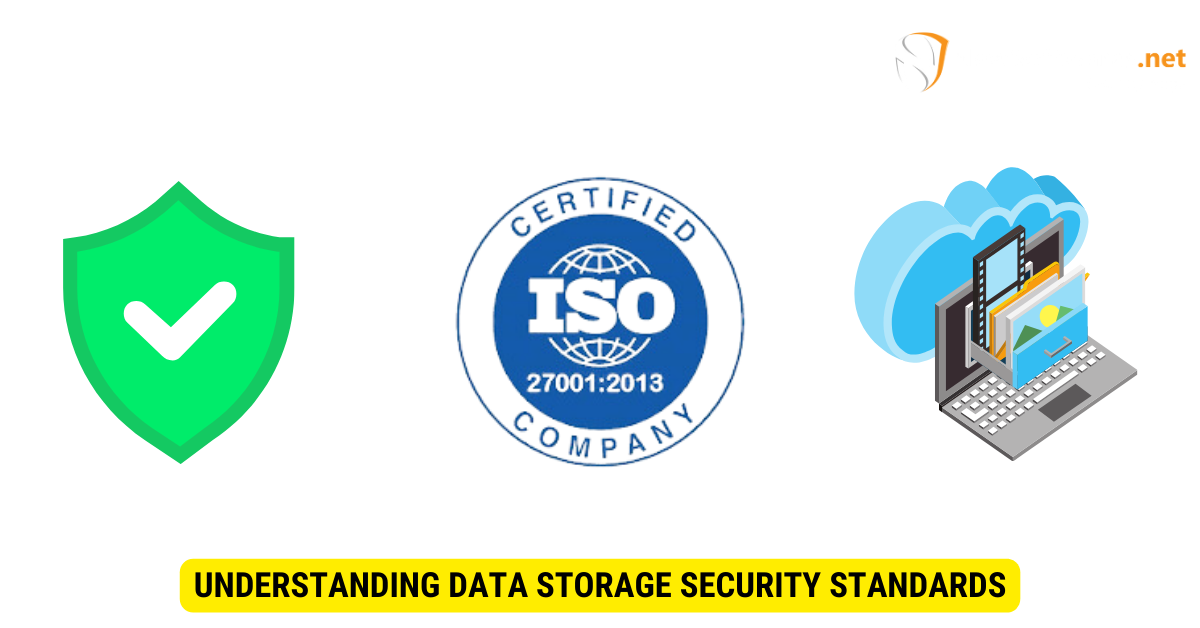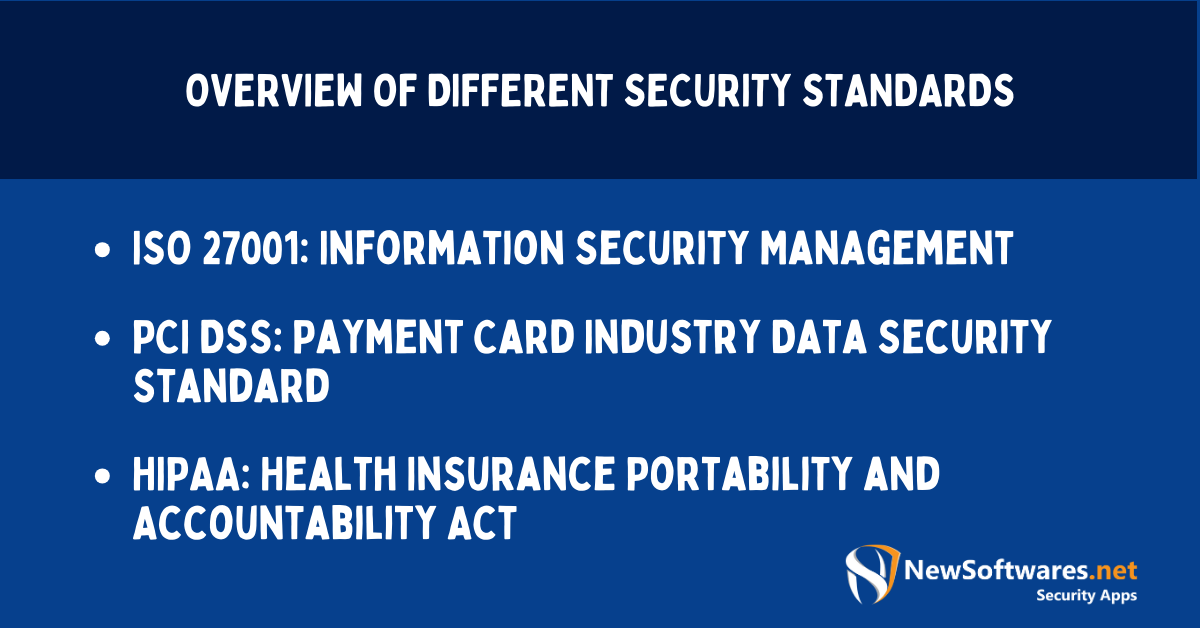One of the strictest security standards for data storage is the ISO/IEC 27001, an international standard for managing information security.
Data storage security is a critical concern for organizations across various industries. With the growing occurrence and sophistication of cyber threats, protecting sensitive data from unauthorized access or compromise is essential. To address this challenge, several security standards have been developed to ensure the highest level of protection for data stored electronically. I will explore these standards and identify the strictest security standard for data storage.
Understanding Data Storage Security Standards

Data storage security standards provide comprehensive guidelines and best practices for safeguarding data from potential vulnerabilities and breaches. These standards help organizations establish a robust security framework and implement measures to protect their data infrastructure. A comprehensive understanding of these standards is essential for organizations seeking to enhance their data storage security.
Data storage security standards are designed to address the ever-growing threat landscape and the increasing sophistication of cyber attacks. These standards consider various factors, such as the type of data being stored, the industry in which the organization operates, and the regulatory requirements that need to be met. By adhering to these standards, organizations can ensure that their data storage practices align with industry best practices and are in line with legal and regulatory obligations.
One of the key benefits of implementing data storage security standards is the ability to establish a strong security posture. These standards provide organizations with a framework to identify and mitigate potential risks and vulnerabilities. By following these guidelines, organizations can implement robust access controls, encryption mechanisms, and intrusion detection systems to protect their data from unauthorized access and malicious activities.
The Importance of Data Security
Data security is crucial for maintaining trust and credibility with customers and stakeholders. Data breaches can have severe penalties, including financial losses, reputational damage, and legal liabilities. Organizations that fail to prioritize data security may face significant financial and legal repercussions and a loss of customer trust.
Furthermore, data security is important for protecting sensitive customer information and safeguarding valuable intellectual property and trade secrets. Administrations invest significant resources in research and development, and a breach of their data storage systems can result in the theft of valuable information that can be detrimental to their competitive advantage.
Key Elements of Data Storage Security
Data storage security encompasses multiple components, each vital in protecting sensitive information. These elements include access controls, encryption, intrusion detection systems, vulnerability assessments, and auditing processes.
Access controls ensure that only authorized individuals have access to sensitive data. This can be achieved by implementing solid authentication mechanisms, such as multi-factor authentication, and using role-based access controls to limit access to specific data based on job roles and responsibilities.
Encryption is another critical element of data storage security. By encoding data at rest and in transit, organizations can ensure that even if the data is compromised, it remains unreadable and unusable to unauthorized individuals. Encryption algorithms and key management processes play a crucial role in preserving the integrity and confidentiality of data.
Intrusion detection systems are planned to monitor network traffic and identify suspicious or malicious activities. These systems can detect and alert organizations to potential security breaches, allowing them to mitigate the impact and prevent further damage immediately.
Vulnerability assessments are essential for identifying potential weaknesses in data storage systems. By regularly conducting vulnerability assessments, organizations can proactively recognize and address vulnerabilities before malicious actors can exploit them. This helps establishments stay one step ahead of potential threats and secure their data storage systems.
Auditing processes play a crucial role in data storage security by giving organizations visibility into their data storage practices and identifying potential compliance issues. Regular audits help establishments identify gaps in their security measures and ensure they meet industry standards and regulatory requirements.
In conclusion, understanding data storage security standards is vital for organizations seeking to protect sensitive information. By implementing robust security measures and adhering to industry best practices, organizations can enhance their data storage security posture and mitigate the risks associated with data breaches. Prioritizing data security helps organizations maintain trust and reliability with customers and stakeholders and guarantees compliance with legal and regulatory obligations.
Overview of Different Security Standards

There are several widely recognized security standards that organizations can adopt to strengthen their data storage security. These standards provide guidelines for implementing security controls and ensuring compliance with industry regulations. Let’s explore some of the most prominent standards:
ISO 27001: Information Security Management
The ISO 27001 standard outlines best practices for establishing, implementing, maintaining, and continually improving an info security management system (ISMS). It provides an organized approach to managing sensitive company information and mitigating risks associated with data storage.
Organizations certified with ISO 27001 are committed to information security and have implemented comprehensive security controls to protect their data.
PCI DSS: Payment Card Industry Data Security Standard
PCI DSS is a security standard that main payment card brands recognize to protect cardholder data. It applies to organizations that handle cardholder information, including merchants, service providers, and financial institutions. Compliance with PCI DSS ensures organizations maintain a secure environment to process payment card transactions and safeguard sensitive data.
HIPAA: Health Insurance Portability and Accountability Act

HIPAA establishes standards for protecting health information maintained or transmitted by healthcare organizations. It mandates various administrative, technical, and physical safeguards to certify the security and privacy of protected health information (PHI). Organizations that handle electronic PHI must comply with HIPAA requirements to safeguard patient confidentiality and prevent data breaches.
The Strictest Security Standard: FIPS 140-2
While all the security above standards provide effective guidelines for data storage security, one standard stands out as the strictest: FIPS 140-2.
Understanding FIPS 140-2
FIPS 140-2, Federal Information Processing Standard 140-2, is a U.S. government standard specifying the security requirements for cryptographic modules used in various applications, including data storage. The standard evaluates the strength and effectiveness of encryption algorithms and cryptographic key management systems.
Why FIPS 140-2 is Considered the Strictest Standard
FIPS 140-2 is the strictest security standard because it rigorously evaluates cryptographic modules against stringent requirements. The standard defines four different security levels, each increasing complexity and offering enhanced security features. FIPS 140-2 Level 4 is the highest and requires the most robust protection mechanisms, making it the strictest standard for data storage security.
Implementing FIPS 140-2 in Data Storage
Implementing FIPS 140-2 compliance for data storage can be complex and challenging. However, the benefits of achieving this stringent standard outweigh the difficulties involved. Here are some steps organizations can take to achieve FIPS 140-2 compliance:
Steps to Achieve FIPS 140-2 Compliance
- Perform a thorough assessment of existing systems and identify areas that need improvement.
- Develop robust encryption mechanisms to protect data at rest and in transit.
- Establish strong access controls and authentication measures to guarantee that only authorized individuals can access sensitive data.
- Regularly update and patch systems to address vulnerabilities and stay up-to-date with evolving threats.
- Build a comprehensive incident response plan to manage and mitigate potential security incidents effectively.
Challenges in Implementing FIPS 140-2
Implementing FIPS 140-2 compliance comes with its own set of challenges. The stringent requirements and rigorous testing processes can be resource-intensive and require significant technological, expertise, and infrastructure investments. Additionally, organizations must ensure ongoing maintenance and regular audits to maintain compliance with FIPS 140-2.
The Future of Data Storage Security Standards
Data storage security standards continue to evolve to keep up with emerging technologies and sophisticated cyber threats. Here are some emerging trends that are shaping the future of data storage security:
Emerging Trends in Data Security
Artificial Intelligence (AI) and Machine Learning (ML) technologies are being deployed to enhance data storage security by identifying patterns and anomalies, detecting potential threats in real time, and automating incident response.
Blockchain technology is also gaining traction as a means to secure data storage through its decentralized, tamper-proof nature.
The Role of Encryption in Future Standards
Encryption will continue to play a crucial role in future data storage security standards. As the volume of data being stored and transmitted increases, encryption will become even more critical in mitigating risks and protecting sensitive information.
Future standards will likely emphasize strong encryption algorithms and recommend the adoption of industry best practices to ensure the confidentiality and integrity of stored data.
Key Takeaways
- ISO/IEC 27001 is globally recognized.
- The standard requires regular audits and reviews.
- It covers all aspects of information security, not just data storage.
- Achieving certification demonstrates a commitment to security.
- The standard emphasizes risk management and continuous improvement.
FAQs
What is the focus of ISO/IEC 27001?
It focuses on establishing, maintaining, and improving an information security management system (ISMS).
How often should a company be re-certified?
Regular audits are required, with a re-certification typically every three years.
Does ISO/IEC 27001 only apply to large organizations?
No, it applies to organizations of any size and type.
Is ISO/IEC 27001 compliance mandatory?
Not globally, but some industries or countries may require it or its equivalent.
What are the benefits of being ISO/IEC 27001 certified?
It demonstrates a commitment to security, can lead to better business opportunities, and reduces the risk of breaches.
Conclusion
In conclusion, data storage security standards are vital in protecting sensitive information and preventing data breaches. While there are several recognized security standards, FIPS 140-2 stands out as the most rigorous standard for data storage security. Implementing FIPS 140-2 compliance comes with challenges, but the benefits of data protection and compliance outweigh the difficulties. As technology evolves, future standards will focus on emerging trends such as AI, ML, and blockchain, while encryption will remain a fundamental component of data storage security standards. By staying informed and implementing the necessary measures, establishments can ensure the highest level of security for their valuable data assets.
